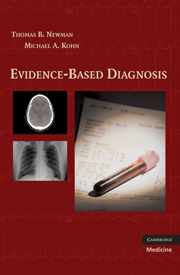Book contents
- Frontmatter
- Contents
- Preface
- Acknowledgments & Dedication
- Abbreviations/Acronyms
- 1 Introduction: understanding diagnosis and diagnostic testing
- 2 Reliability and measurement error
- 3 Dichotomous tests
- 4 Multilevel and continuous tests
- 5 Critical appraisal of studies of diagnostic tests
- 6 Screening tests
- 7 Prognostic tests and studies
- 8 Multiple tests and multivariable decision rules
- 9 Quantifying treatment effects using randomized trials
- 10 Alternatives to randomized trials for estimating treatment effects
- 11 Understanding P-values and confidence intervals
- 12 Challenges for evidence-based diagnosis
- Answers to problems
- Index
- References
5 - Critical appraisal of studies of diagnostic tests
Published online by Cambridge University Press: 04 August 2010
- Frontmatter
- Contents
- Preface
- Acknowledgments & Dedication
- Abbreviations/Acronyms
- 1 Introduction: understanding diagnosis and diagnostic testing
- 2 Reliability and measurement error
- 3 Dichotomous tests
- 4 Multilevel and continuous tests
- 5 Critical appraisal of studies of diagnostic tests
- 6 Screening tests
- 7 Prognostic tests and studies
- 8 Multiple tests and multivariable decision rules
- 9 Quantifying treatment effects using randomized trials
- 10 Alternatives to randomized trials for estimating treatment effects
- 11 Understanding P-values and confidence intervals
- 12 Challenges for evidence-based diagnosis
- Answers to problems
- Index
- References
Summary
Introduction
We have learned how to quantify the reliability (Chapter 2) and accuracy (Chapters 3 and 4) of diagnostic tests. In this chapter, we turn to critical appraisal of studies of diagnostic tests, with an emphasis on problems with study design that affect the interpretation or credibility of the results. After a general discussion of an approach to studies of diagnostic tests, we will review some common biases to which studies of test accuracy are uniquely or especially susceptible and conclude with an introduction to systematic reviews of studies of diagnostic tests.
General approach
A general approach to critical appraisal of studies of diagnostic tests is to break the study down into its component parts and consider strengths and weaknesses of each, as outlined in Table 5.1. Begin with the research question: is it a question to which you really want to know the answer? Is the test (or history or physical examination finding) being studied one that you have used or could use for your patients? Is the entity being diagnosed one that is important?
Next, consider the study design. All study designs (cross-sectional, case–control, cohort, randomized trial, etc.) have strengths and weaknesses. Watch out for studies of diagnostic tests with a case–control design, in which subjects with the disease are sampled separately from those without the disease.
- Type
- Chapter
- Information
- Evidence-Based Diagnosis , pp. 94 - 115Publisher: Cambridge University PressPrint publication year: 2009
References
- 5
- Cited by



